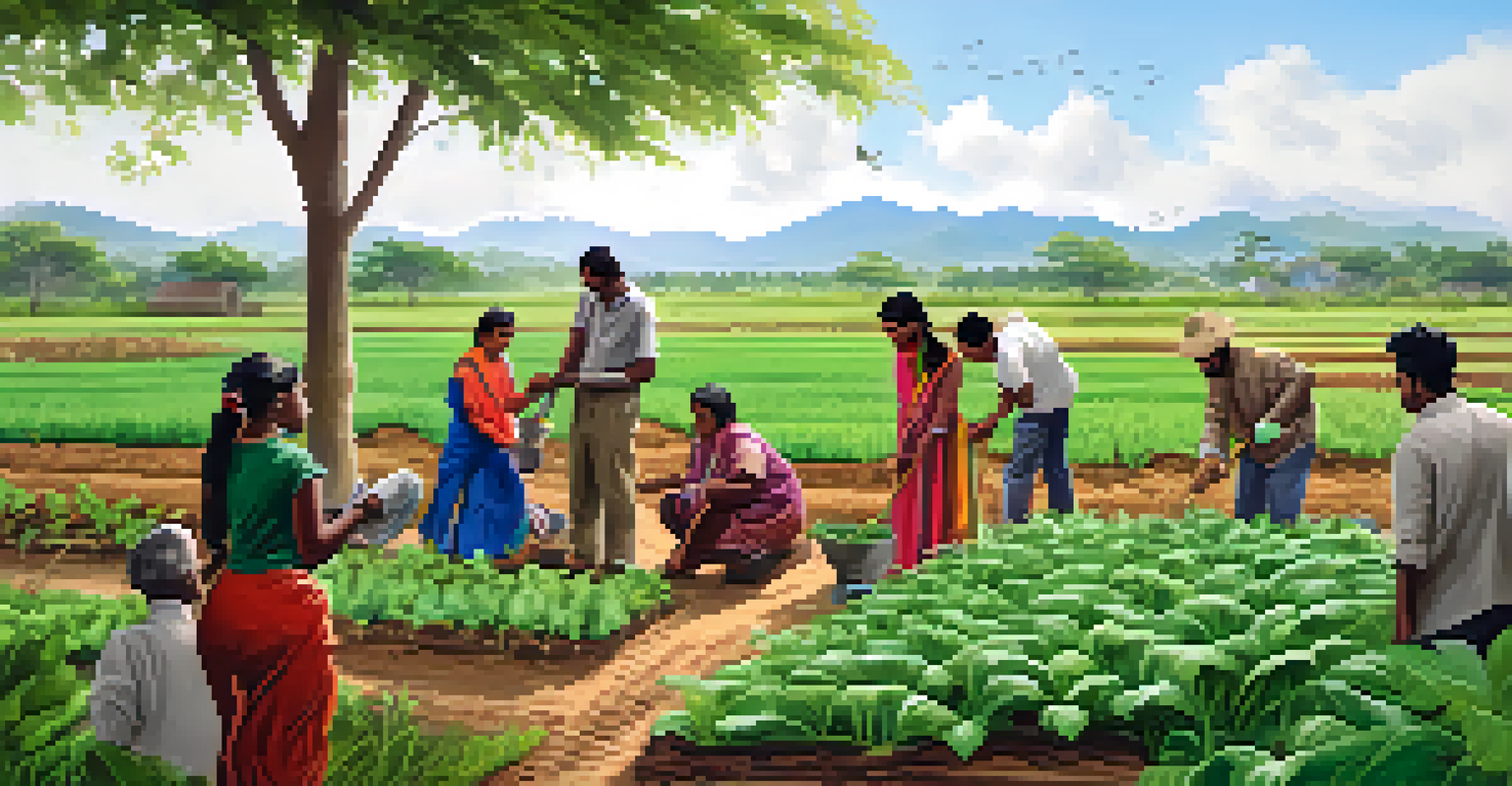How Wildlife Corridors Enhance Biodiversity in Brazil

Understanding Wildlife Corridors and Their Importance
Wildlife corridors are vital pathways that connect fragmented habitats, allowing animals to move freely between them. In Brazil, these corridors play a crucial role in supporting biodiversity, offering safe passage for various species that might otherwise struggle to survive. Imagine a busy highway where animals can safely cross; that's essentially what these corridors provide, reducing the risks of inbreeding and increasing genetic diversity.
The future will be shaped by the decisions we make today regarding our natural resources and ecosystems.
These corridors are especially important in a biodiverse region like Brazil, home to the Amazon rainforest and the Atlantic Forest. As urbanization and agriculture expand, natural habitats become isolated, resembling islands in a sea of development. Corridors act as bridges between these islands, ensuring that wildlife populations can thrive and adapt by reaching new habitats and resources.
Moreover, the benefits of wildlife corridors extend beyond the animals themselves. They contribute to healthier ecosystems, which in turn support human communities by providing services like clean water and pollination. Encouraging biodiversity through these corridors is not just an environmental issue; it's integral to our survival and well-being.
Key Biodiversity Hotspots in Brazil
Brazil is home to several biodiversity hotspots, rich in unique species and ecosystems. The Amazon rainforest, for instance, is often referred to as the 'lungs of the Earth' and hosts an incredible variety of flora and fauna. Corridors in this region facilitate the movement of species like jaguars and tapirs, which are essential for maintaining ecological balance.

Another significant hotspot is the Atlantic Forest, which has seen drastic habitat loss due to urbanization and agriculture. Wildlife corridors here are crucial for the survival of endangered species such as the golden lion tamarin. By linking fragmented patches of forest, these corridors help ensure that these unique animals can find mates and resources necessary for their survival.
Local Communities Drive Conservation
Engaging local communities in conservation efforts fosters ownership and promotes sustainable practices that benefit wildlife.
These hotspots highlight the urgent need for maintaining and expanding wildlife corridors. By prioritizing these areas, Brazil can protect its incredible biodiversity and enhance the resilience of its ecosystems against climate change and human impact.
Examples of Successful Wildlife Corridors
One shining example of a successful wildlife corridor in Brazil is the Corredor Ecológico do Alto Tietê. This initiative connects urban areas with natural reserves, allowing wildlife to thrive amid human development. Species such as the capybara and various bird species have benefited from this corridor, illustrating how urban planning can align with conservation goals.
In the end, we will conserve only what we love; we will love only what we understand; we will understand only what we are taught.
Another notable project is the Corridor of the Atlantic Forest, which connects numerous protected areas along Brazil's southeastern coast. This corridor has proven effective in supporting the movement of species like the maned wolf and the southern tamandua, showcasing how strategic planning can restore ecological connectivity.
These successful corridors serve as models for future projects across Brazil and beyond. They demonstrate that with thoughtful design and community involvement, we can enhance biodiversity while accommodating human needs, creating a harmonious balance between nature and development.
The Role of Local Communities in Corridor Success
Local communities play a pivotal role in the success of wildlife corridors. By engaging residents in conservation efforts, we can foster a sense of ownership and responsibility toward preserving their environment. For instance, community-led initiatives that promote sustainable farming practices can reduce habitat destruction, allowing corridors to flourish.
Education is critical in this process. When people understand the importance of biodiversity and wildlife corridors, they are more likely to support and participate in conservation efforts. Workshops and outreach programs can empower communities to become stewards of their local ecosystems, leading to more sustainable practices and better outcomes for wildlife.
Wildlife Corridors Enhance Biodiversity
Wildlife corridors connect fragmented habitats, allowing species to thrive and maintain genetic diversity.
Furthermore, involving local communities in decision-making processes ensures that their needs and concerns are addressed. This collaborative approach not only strengthens the effectiveness of wildlife corridors but also builds resilience within communities, making them active participants in the fight for biodiversity.
Challenges Facing Wildlife Corridors in Brazil
Despite their importance, wildlife corridors in Brazil face significant challenges. One major issue is land use change, driven by agriculture, urban expansion, and infrastructure development. As these activities fragment habitats, the effectiveness of existing corridors can be compromised, limiting wildlife movement and reducing biodiversity.
Another challenge is funding and resource allocation for conservation projects. Many wildlife corridors require ongoing maintenance and monitoring to be effective, yet financial support can be inconsistent. Without adequate funding, these projects may struggle to meet their goals, putting biodiversity at risk.
Additionally, climate change poses a growing threat to wildlife corridors. As temperatures rise and weather patterns shift, the habitats that corridors connect may also change, potentially leading to mismatches in species distributions. This underscores the need for adaptive management strategies that can respond to these evolving challenges.
The Economic Value of Biodiversity in Brazil
Biodiversity isn't just an environmental concern; it holds significant economic value as well. Healthy ecosystems provide essential services, such as pollination, water purification, and carbon storage. By enhancing biodiversity through wildlife corridors, Brazil can bolster its economy and ensure sustainable development for future generations.
Additionally, Brazil's rich biodiversity attracts ecotourism, which can be a major economic driver. Tourists flock to the Amazon and Atlantic Forest to witness their unique wildlife, contributing to local economies and promoting conservation efforts. Investing in wildlife corridors can enhance these experiences, ensuring that visitors can witness thriving ecosystems.
Economic Benefits of Biodiversity
Enhancing biodiversity through wildlife corridors not only supports ecosystems but also boosts Brazil's economy through ecotourism.
Ultimately, recognizing the economic benefits of biodiversity reinforces the importance of wildlife corridors. By safeguarding natural habitats, Brazil can create a sustainable future that balances economic growth with environmental responsibility.
Future Directions for Wildlife Corridors in Brazil
Looking ahead, the future of wildlife corridors in Brazil holds great promise. Continued collaboration between government agencies, NGOs, and local communities will be essential for expanding and maintaining these vital connections. Innovative approaches, such as the use of technology for monitoring wildlife, can enhance the effectiveness of corridor projects.
Additionally, integrating wildlife corridors into urban planning can create more sustainable cities. By designing green spaces that incorporate these corridors, we can ensure that urban development aligns with conservation goals, benefiting both wildlife and residents.

Ultimately, the future of wildlife corridors in Brazil will depend on our collective commitment to protecting biodiversity. By embracing innovative strategies and fostering community involvement, we can create a legacy of thriving ecosystems that support both wildlife and people for generations to come.